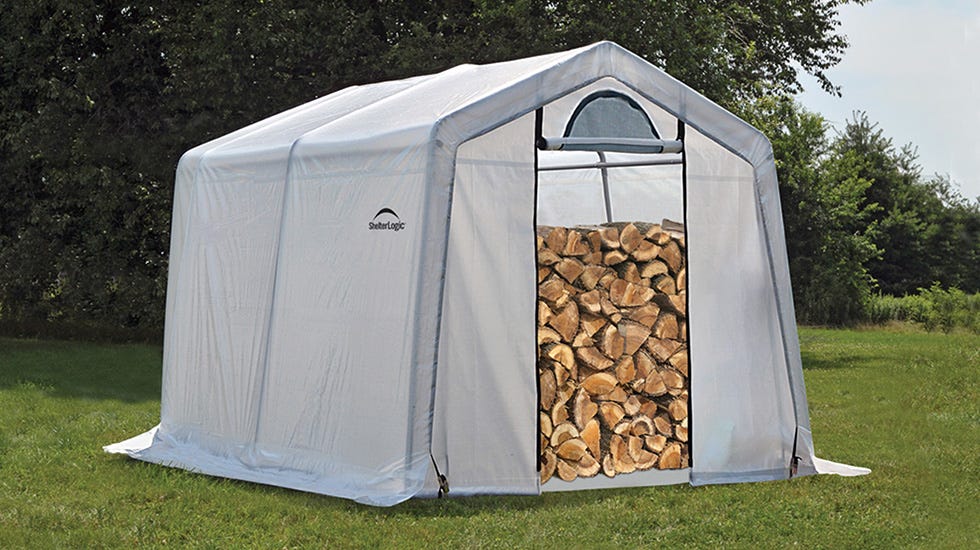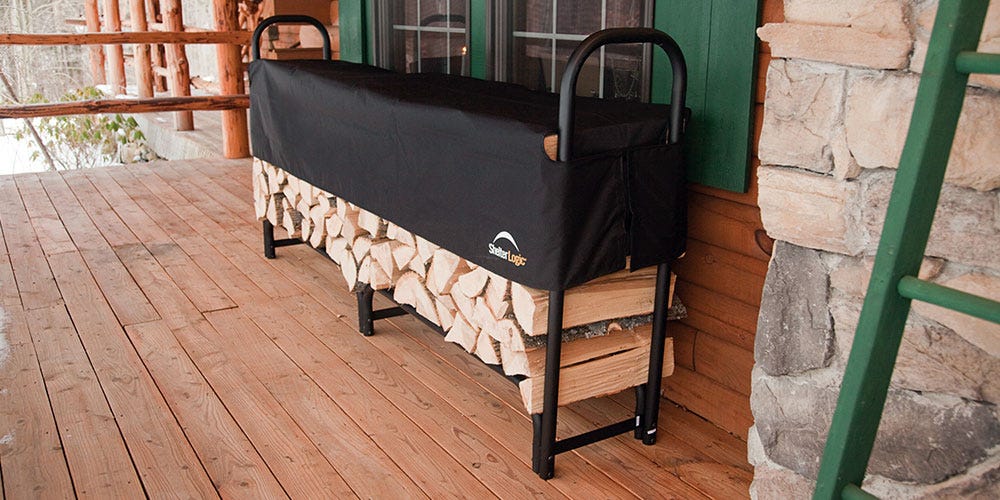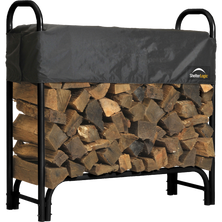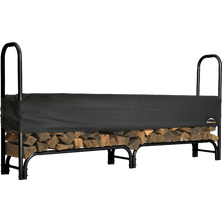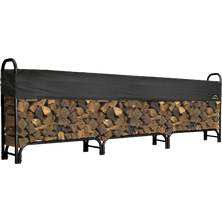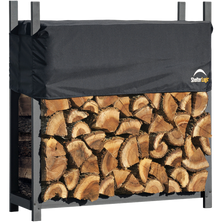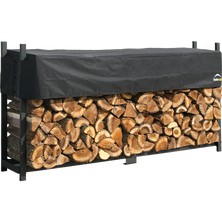Have you spent plenty of time over the summer working on seasoning your firewood? Do you heat your home with a burning fireplace or a fire stove? A steady supply of firewood keeps the heating costs down and is a much more environmentally-friendly fuel source than other heating options, unlike coal and oil. Then learning how to stack the firewood appropriately will be a valuable skill to have.
When you start a firewood stack the right way, it will take around a year to properly stack it. That is why it is so important that you do it the right way right away.


How To Stack Firewood
When you stack seasoned firewood, do it in a way that allows it to either naturally dry out or to stay dry. There are three primary facets of a well-done firewood stack. You need to keep the firewood raised from the ground, keep them covered in the right way and stack them appropriately.
- Raise the Firewood. Keep the firewood off the ground. It is best to try to have a base built up from the soil. Some people build a plywood rack, although concrete will last much longer. You can also find racks or bases made out of metal.
- Keeps Firewood Covered. Although it might seem like a good idea to keep the whole stack completely covered with a tarp or put the wood in an enclosure. However, this stops the air from breathing so that the humidity from the air will affect the wood. Instead, use wood with bark on one side to protect the top of the stack and let the rest of it breathe. It will dry out from rain faster than it will from maintained levels of humidity.
Holzhaufen/Holz Method
This is also called the German method. It is a design that allows the air to flow all the way to the center of the stack so that each piece of wood can stay dry. In total, the stack ends up being approximately six feet in diameter and can be up to about seven feet high.
- Break all your firewood pieces so that they measure between 12 to 24 inches long. They should be about the same width to create a uniform pile and maintain the stack's integrity.
- Use a seven-foot stake in the middle of the pile. This stake becomes your basis for the firewood stack. Lay the firewood down, pointing one end toward the stake and the other toward the outside to create a circle eventually.
- Continue the circular pattern for up to seven feet, or however high your stake is.
- You can cover the top of the pile with something more protective, like a tarp, but this will decrease the airflow that can get to the pile's center. The traditional method is to place a piece of wood with thick bark facing upward at the top to protect the wood from moisture.
Circle Stack Method
This method is very similar to the German method. You end up using a symmetrical circle pattern that is completely self-sustaining so that you don't have to use a rack or build a large, protective shed. The method has changed slightly over the years and across countries as it is quite popular in Europe and is spreading to the U.S. as well.
- Create your pile in a sunny area that gets good circulation and where the water doesn't pool.
- Draw your circle for a visualization of your pile. The circle should range between eight and 10 feet in diameter.
- Grab your logs and set them around the edge of the circle to create its bottom layer.
- Continue doing this, adding layers of wood in the circle's perimeter. They should be about the same size and shape.
- Any small pieces or ones that are oddly shaped, add them to the middle of the circle.
- Once you get to the top of the circle, lay the top layer at an angle so that the pieces of wood lay across the top of the pile's center.
End Pillar Stack Method
The End Pillar Stack method is arguably the most popular globally. It is a classic and one of the easier ways you can create a firewood stack to keep everything aerated yet dry. You need to use relatively uniform pieces of wood for the "pillars" created in this method.
- Construct the towers by taking two logs of similar dimensions and turning them to parallel each other.
- Build up the next layer by laying to parallel logs, this time perpendicular to the first set you laid.
- Continue using uniform logs to build the layers until you have gotten to about twelve levels. You should stop when you get high enough that the pile would start to get unwieldy.
- Create the second tower, but put it several feet away from the first tower.
- Between the two towers lay logs close together so that their cut ends face the prevailing winds. Keep in mind that in the United States, the weather tends to move from the West to the East. So if you don't know which direction the wind comes from most frequently, that is your best bet.
- Continue to layer between the stacks until your pile is the same height as your towers.
- Place the top pieces of wood so that their bark side is up. That stops them from shedding moisture into the pile.
- At the end of the pile's construction, use long sticks to help stabilize the pile. Plant them firmly in the ground and then lean them against the pile.


You don't want to stack your end tower piles too neatly. Although it might look satisfying, this will only end up stifling your piles. In addition, it doesn't allow for enough air ventilation to keep the wood well seasoned.
Firewood Rack Method
The firewood rack method is one of the tried-and-true methods used around the world for firewood stacking. A rack can range widely in size and shape, giving you the chance to store as much firewood as you need.
- Use pieces of wood of approximately the same size. First, lay them side by side to form one layer on the rack. Then, lay the next layer in the opposite direction.
- Continue to stack the pile about four feet high. Make sure as you go that your stack is stable, and if you press on it, it won't wobble.
- Fill any large gaps in with smaller pieces of wood to give the pile extra strength. However, don't overpack it, or the pile won't be able to breathe enough.
The Shaker Method
This method uses a round formation similar to the first two methods we described. This time, however, the circle spirals and ends up looking a little like an old-fashioned wheel. The odd shapes of these logs give an interesting aesthetic to give a good visual presence for your yard. Use this method if you need something quick to help the wood dry fast.
- Start by using a log about eight inches wide and 16 inches long to form the center of the pile. Next, construct the rest of the base with split logs to form a circle like a wheel's spokes. Make the base at least two rows deep.
- Add two split logs to the center of the pile. Continue to build the stack by leaning more firewood against it. Add layers in this manner until the pile is about shoulder height. It should end up creating a disc shape.
- Stop your pile when it forms a cone, and you can't add any more wood.
Firewood Stacking Tips
Firewood stacking might seem straightforward. However, quite a few tips help you figure out the best way to stack firewood. These help you ensure that the hard work you did seasoning the firewood doesn't go to waste. The tips help you to make sure the seasoned wood lasts as long as you intended.
- Keep the wood dry and sheltered. If the wood is currently covered, use a tarp to cover the top of the wood. However, you don't want the tarp to cover the entire pile of wood so that the rest of the woodpile can breathe.
- No matter how you decide to stack the logs, they all need to be level, or you risk them falling over.
- If you have square-cut logs, use them to build columns. Round logs work well in the main pile when the largest are stacked on the bottom for support.
- Create a pile in a way that will allow any moisture that can get into the woodpile to leave the stack.
- Whenever you stack wood or rearrange the pile, you should wear work boots with steel toe protection. Individually, the pieces of wood aren't that heavy, but multiple falling from a height can do serious damage.
Firewood Stacking and Storage
You have all kinds of options when it comes to storing and stacking your firewood. Using one of our five will practically guarantee a hot fire so you can stay toasty warm all winter long.

